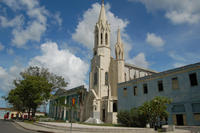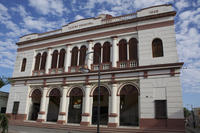You are in: Caribbean -> Cuba -> Historic Centre of C... , and traditional search or Image Gallery will yield results of this site only
Historic Centre of Camagüey
| Site number: | 1270 |
|
| Type of site: | Cultural | |
| Date: | 1528 | |
| Date of Inscription: | 2008 | |
| Location: | South America, Carribean, Cuba, Camagüey Province | |
Up to 75 images are shown here. Click on each for more details or on Image Gallery for more images.
| Description: | Camagüey, was one of the first seven Spanish settlements in Cuba, and it played a major role as an urban centre devoted to cattle breeding and the sugar industry. It settled in its current location in 1528, and developed a highly exceptional (for Latin America), irregular urban pattern that encloses an arrangement of large and minor squares, meandering streets, alleys and irregular urban blocks. The Historic Center of Camagüey stretches 54 hectares, constituting a unique example of a traditional urban settlement remote from major trade routes. The Spanish colonizers’ urban layout and traditional construction techniques were influenced by European medieval traditions, arriving in the Americas through Spanish masons and construction masters. The architecture of the site is largely eclectic and reflects the influence of different styles through the ages, such as, neo-classical, Art Deco, neo-colonial, and to a lesser extent, Art Nouveau and rationalism. --WHMNet paraphrase from the description at WHC Site, where additional information is available. | |
| Camagüey is a city and municipality in central Cuba and is the nation's third largest city. It is the capital of the Camagüey Province. After almost continuous attacks from pirates the original city (founded as Santa María del Puerto del Príncipe around 1515 on the northern coast) was moved inland in 1528. The new city was built with a confusing lay-out of winding alleys that made it easier to defend it from any raiders. There are many blind alleys and forked streets that lead to squares of different sizes. There is only one exit from the city; should pirates ever return and succeed in entering the city, the hope was that the local inhabitants would be able to entrap and kill them. In July 2008, the old town was designated a UNESCO World Heritage Site, but in September it suffered damage as colonial columns were toppled and the ornate sculptures on the roofs of centuries-old buildings were smashed by Hurricane Ike. --Wikipedia. Text is available under the Creative Commons Attribution-ShareAlike License. | ||
| Source: | http://whc.unesco.org/en/list/1270 | |
| Reference: | 1. UNESCO World Heritage Center, Site Page. | |
















